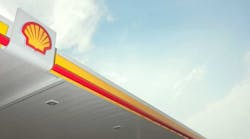Royal Dutch Shell Plc (IW 1000/2) will build seven fueling stations for hydrogen cars in California through a partnership with Toyota Motor Corp. (IW 1000/6), laying down their latest bet on the demise of the internal-combustion engine.
The stations will nudge the state closer to its goal of having 100 retail sites by 2024 where hydrogen fuel-cell vehicles can fill up. The California Energy Commission is considering $16.4 million in grants toward the stations, with Shell and Toyota contributing $11.4 million.
The Shell-Toyota partnership “shows there’s a lot of interest and that the hydrogen market is poised to move forward rapidly,” said Janea Scott, a member of the California commission.
Toyota plans to rely on hydrogen to all but rid its lineup of traditional-engine models by 2050. The lack of refueling infrastructure is a major hurdle to zero-emission cars catching on with consumers -- California has just 25 stations right now.
Shell also is crafting a strategy to wean itself off oil. Demand could peak in as few as five years, Chief Financial Officer Simon Henry said in November. The company operates six hydrogen stations -- four in Germany and two in the Los Angeles area -- and will open a seventh near London’s Heathrow Airport later this month.
Shell at Forefront
“Shell wants to be in the forefront of this technology,” said Oliver Bishop, general manager for hydrogen. The complexities of producing, storing and delivering the fuel necessitates “the support of governments and of car companies like Toyota to make it work.’’
California has the toughest clean-air rules in the country and mandates for zero-emission vehicles, making it the natural place for Shell and Toyota to team up in the U.S. While the Trump administration has indicated it may weaken environmental rules, California is aligned with countries in Europe and Asia. Shell belongs to a German government-backed consortium targeting 400 stations by 2023. Tokyo plans to spend 45.2 billion yen (US$400 million) on fuel-cell vehicle subsidies and hydrogen stations by the time of the 2020 Olympic Games.
For Toyota, there’s no question fossil fuel-burning cars will be shunned or even outlawed in a few decades, and that the alternative they’ve worked on for 25 years will be ready to take over.
No Combustion Allowed
“When no more combustion of fuel is allowed, hydrogen will become one of the major sources of fuel, of that we’re confident,” said Kiyotaka Ise, Toyota’s president of advanced research and development and engineering.
The automaker’s long bet is that people will prefer cars like its Mirai -- “the future” in Japanese -- over plug-in electric models. The hydrogen-powered Mirai has a superior driving range and can be tanked up in three minutes -- no hours-long charging involved. Only harmless H20 dribbles out of its rear end.
Four companies should be selling fuel cell vehicles this year in California: Toyota, Honda Motor Co., Hyundai Motor Co. and Daimler AG. While Toyota has rendered hybrids commonplace, the industry is facing pressure for more zero-emission products from governments that see carbon pollution as a threat. Fully electric cars from Tesla Inc. and others are sparking interest.
Paris, for instance, has introduced rules to ban all but zero-emission and newer-model vehicles from the streets by 2020. China may mandate more new-energy cars and has set a goal for 3 million units to be sold annually by 2025, a six-fold increase from last year.
Disruptive Transition
Hydrogen fuel cell vehicles are still in their infancy in terms of commercial production, two years after Toyota’s Mirai hit the market. But the potential payoff of Toyota’s bet is huge, said Larry Burns, General Motors Co.’s retired chief of research and development.
The Japanese automaker is gunning for the sort of decisive competitive advantage it scored with the Prius hybrid that debuted 20 years ago. “This is not a linear transition -- it’s disruptive,” Burns said.
Toyota’s plans to sell 10-times more hydrogen cars in 2020 than the 3,000 planned for this year. By 2025, Toyota figures it’ll be able to price them at close to what it charges for hybrids. The price in today’s dollars could be around $35,000, about the same as the Tesla Model 3, said Keith Wipke, a fuel-cell program manager at the National Renewable Energy Laboratory in Golden, Colorado.
Hydrogen Skeptics
Fuel cell vehicle skeptics have a litany of arguments against them. For starters, the word “hydrogen” may evoke memories of the Hindenburg, the airship that caught fire over New Jersey in 1937 and killed 36, or the H-bomb, a precursor to what the U.S. dropped on Japan to end World War II.
The pro-hydrogen forces’ response: The lightest and most common element on the planet is indeed highly flammable, but the risks have long been proven to be manageable.
“Hydrogen is clean. It’s flexible and has many applications. What’s not to like about it?” said Shell’s Bishop.
Elon Musk, Tesla’s chief executive officer, isn’t a believer. He’s betting people will prefer to buy battery-powered autos and power them with solar panels and home energy-storage devices. Musk contends that’s more efficient than splitting hydrogen from water, then compressing, storing and transporting it to stations that can pump it into cars like the Mirai.
“Fuel cell is so bulls---,” Musk said at a Tesla service center in Germany in October 2013. (Toyota began its U.S. promotional campaign for Mirai in April 2015 with a video documentary on generating hydrogen using cow manure.)
Musk may be inadvertently helping Toyota’s cause. Early on, Big Oil wasn’t convinced cars could make the zero-emission switch in droves. Then Tesla took about 373,000 pre-orders for its Model 3 sedan last year. The oil industry was “a bit scared” by the feverish reception, said Katsuhiko Hirose, a Toyota project general manager.
Global Hydrogen Council
Now some of those companies are coming around to side with Toyota. Total SA, Air Liquide SA, Linde AG and Shell are among 13 companies that last month formed a global hydrogen council. They’ll invest $10.7 billion in hydrogen-related products within five years.
There’s a long road ahead. Toyota won’t disclose how much it’s losing on the Mirai, which sells for $57,500 in the U.S., and only in California.
Building the car is so painstaking that the production line is devoid of robots. The Mirai’s guts include two fiber-wrapped hydrogen tanks that are tough enough to take shots from high-powered rifles.
Below the Mirai’s two front seats, a stack of 370 cells are each enveloped in titanium mesh that’s about 0.2 millimeters thick and punched with some 40,000 holes. When hydrogen and oxygen flow through them, the chemical reaction creates water and electricity, the latter of which powers the battery and motor.
Toyota started out assembling three Mirai per day at the Motomachi plant near its headquarters in Toyota City, Japan. Output has ramped up to about a dozen every 24 hours. Production constraints contributed to Toyota selling just 1,034 Mirai sedans in the U.S. last year.
“I’m sure at the current volume seen, even our friends or partners don’t fully believe in the actual realization,” Toyota’s Ise said. “But in 2020, we’ll try to convince them.”
By Craig Trudell, Yuki Hagiwara and John Lippert





